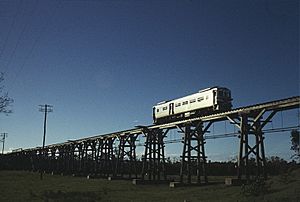Splitters Creek Railway Bridge facts for kids
Quick facts for kids Splitters Creek Railway Bridge |
|
|---|---|

RM 1901 crossing the Splitters Creek railway bridge, circa 1989
|
|
| Location | across Splitters Creek on the Bundaberg - Mount Perry Line, between Oakwood and Sharon, Bundaberg Region, Queensland, Australia |
| Design period | 1870s - 1890s (late 19th century) |
| Built | 1879 - 1880 |
| Official name: Splitters Creek Railway Bridge, Splitters Creek Railway Bridge (Sharon) | |
| Type | state heritage (built) |
| Designated | 21 October 1992 |
| Reference no. | 600529 |
| Significant period | 1870s (fabric) 1881-1993 (historical use) |
| Significant components | abutments - railway bridge, pier/s (bridge) |
| Builders | J & A Overend |
| Lua error in Module:Location_map at line 420: attempt to index field 'wikibase' (a nil value). | |
The Splitters Creek Railway Bridge is a very old railway bridge in Queensland, Australia. It crosses Splitters Creek between the towns of Oakwood and Sharon. This bridge is special because it is listed on the Queensland Heritage Register. This means it is an important historical site that needs to be protected.
The bridge was built a long time ago, between 1879 and 1880. It was part of the railway line that connected Bundaberg to Mount Perry. The company that built it was called J & A Overend.
Contents
Building the Bridge: A Tricky Task
Building the Splitters Creek bridge was quite a challenge! The company, J. & A. Overend and Company, started working on the railway in November 1878. However, the bridge part of the project caused many delays in 1879.
Unexpected Problems Underground
The original plan for the bridge's foundations was to use "screw piles." These are like giant screws that are twisted deep into the ground to support the bridge. But the builders hit a big problem: they found a thick layer of large boulders underground. This made it impossible to use screw piles.
Instead, they had to use something called "caissons." Caissons are large, watertight boxes or cylinders. These were sunk into the ground and then filled with concrete and bricks to create strong foundations.
Overcoming Construction Delays
The builders tried to use "coffer dams" to help sink the piers (the supports that hold up the bridge). Coffer dams are temporary enclosures built in water to create a dry workspace. However, this attempt did not work well and caused more delays.
Finally, in 1880, the bridge was completed. The builders had to get special equipment that used compressed air to help them sink the caissons. Because of all these difficulties, building the bridge cost an extra £1,461. The entire railway section, including the bridge, was finished in February 1881.
Bridge Use and Closure
The railway line from North Bundaberg to Moolboolaman, which included this bridge, opened on July 19, 1881. Over the years, the bridge's old design meant that very heavy trains could not cross it easily. Sometimes, only one train engine was allowed on the bridge at a time, or they had to go very slowly.
The last part of the railway line that used this bridge closed on January 25, 1993.
What the Bridge Looks Like
The Splitters Creek Railway Bridge is made up of different parts. It has two main sections that are 60 feet long. These sections use strong metal "plate girders." Girders are large beams that support the weight of the bridge.
The bridge also has sections made of timber (wood). These wooden parts include 36-foot spans that are made stronger with special supports called "strut and crown." Other wooden parts use "truss" and "tie rods" to make them sturdy. A truss is a framework of beams that creates a strong structure.
The metal girders are connected over two spans. They hold up "cross-girders" which are beams going across the bridge. On top of these, there are long wooden beams called "longitudinal timber stringers." The train tracks rest on these wooden stringers.
Why the Bridge is Important
The Splitters Creek Railway Bridge was added to the Queensland Heritage Register on October 21, 1992. This means it is recognized as an important part of Queensland's history and culture.
A Rare and Old Structure
This bridge is special because it is a very old timber trestle bridge from the late 1800s. A trestle bridge uses a series of frames (trestles) to support the deck. Bridges like this were once common in Queensland, but now they are quite rare.
The metal plate girders used in this bridge are also very old. They are the oldest of their kind still existing in Queensland. This makes the Splitters Creek Railway Bridge a unique example of early railway engineering in the region.


